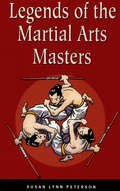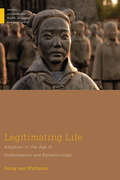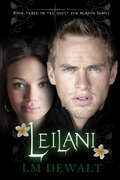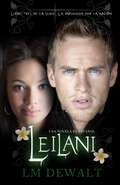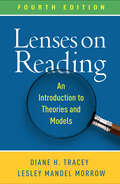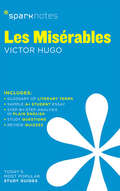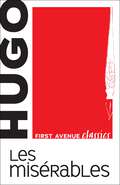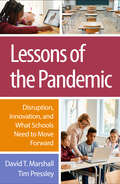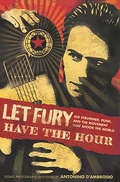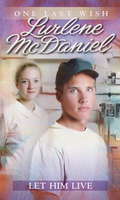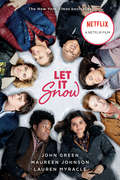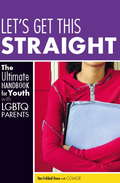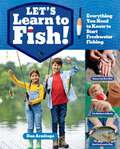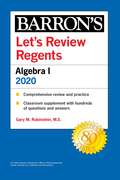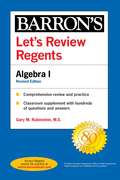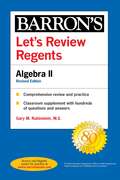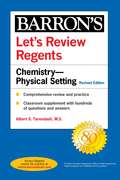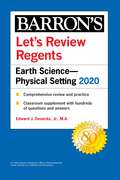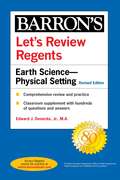- Table View
- List View
Legends of the Martial Arts Masters
by Susan Lynn PetersonWhether you're an inspiring black belt or just a fan of martial arts action, you'll enjoy this collection of twenty exciting stories about the great heroes of the martial arts.The stories include dramatic victories, wily strategies, and triumphs over long odds--from the great Tsukahara Bokuden's cunning defeat of a troublemaking samurai to Wing Chun's brave self-defense against a brutish warlord. Children can read about Robert Trias, known as the "father of American karate" and Miyamoto Musashi, known as the "greatest sword fighter in history" and the author of the bestselling Book of Five Rings.Filled with action and amazing feats of martial arts wizardry, Legends of the Martial Arts Masters will inspire readers with stories of courage, combat, and self-discovery. Stories include: The General Fights a Bull The Great Wave The Hard Way to Find a Teacher The Three Sons The Style of No Sword A Bully Changes His Ways The Ballad of Mu-lan Twelve Warriors of Burma Wing Chun The Eighteen Hands And many more...ayGreat Power, Great ControlThe Strange Disappearance of Morihei UeshibaWhy Has Oyama Shaved His Head TwiceThe Bright Young ManA Tea Master Faces DeathThe CatHow Loyalty Saved Korean Martial ArtsA Kyudo Master Makes a BetFifty Thousand High Blocks
Legitimating Life: Adoption in the Age of Globalization and Biotechnology (Medical Anthropology)
by Sonja van WichelenThe phenomenon of transnational adoption is changing in the age of globalization and biotechnology. In Legitimating Life, Sonja van Wichelen boldly describes how contemporary justifications of cross-border adoption navigate between child welfare, humanitarianism, family making, capitalism, science, and health. Focusing on contemporary institutional practices of adoption in the United States and the Netherlands, she traces how professionals, bureaucrats, lawyers, politicians, social workers, and experts legitimate a practice that became progressively controversial. Throughout the past few decades transnational adoption transformed from a humanitarian response to a means of making family. In this new manifestation, life becomes necessarily economized. While push and pull factors, demand and supply dynamics, and competition between agencies set the stage for the globalization of adoption, international conventions, scientific knowledge, and the language of human rights universalized the phenomenon. Van Wichelen argues that such technoscientific legitimations of a globalizing practice are rearticulating colonial logics of race and civilization. Yet, she also lets us see beyond the biopolitical project and into alternative ways of making kin.
Leila and the Blue Fox
by Kiran Millwood HargraveWeeks pass, to her they are nameless, they are fading and growing light, the warming of weather. On this day, she wakes, and begins to walk. It&’s a summer of firsts for twelve-year-old Leila: her first time traveling alone, first time apart from Amma and her cousin Mona, and first time seeing her mother, a climate scientist in Norway, since war forced their family from Syria six years ago. Together, Leila and her mother&’s research team follow the migration of a tiny Arctic fox, Miso, across ice floes and international borders, hopeful the midnight sun will illuminate how to adapt to a constantly changing world. The Arctic Circle is nothing like Leila has ever imagined—so bright and brutal and undeniably wild. It tests her in every way: her understanding of home and what it means to belong, her determination to do what&’s right, and her belief in how much is possible in even the most impossible of situations. Inspired by an Arctic fox&’s real 2,000-mile trek across continents, Miso's and Leila&’s entwined journeys offer hope in the face of an uncertain future and reinforce that even the smallest voices can make the biggest impact.
Leilani (The Quest for Reason Series #3)
by LM DeWalt"An exciting vampire adventure that will make you fall in love with paranormal genre all over again." ó Page Turners (Lily) Lily, once a solitary and lonely vampire, has finally found the love she longed for in Christian, her husband and newly turned vampire. Once settled in Peru, life is finally taking on a semblance of normalcyódespite the bodyguards protecting them from a cadre of evil vampires desperate for revenge. Lily, Christian, and their friends are on a quest to find their newly adopted sonís long-lost sister, a child with an uncontrollable power, when their son becomes gravely ill and is then taken from his hospital ward. When Christian also inexplicably disappears, and long buried secrets come to light, Lilyís world is turned upside down, forcing her to question her desire to remain a part of the undead world in which sheís lived for almost a century. Read all 3 books in The Quest For Reason series: 1.Lily 2.Datura 3.Leilani
Leilani: Una Novela en Espanol (La Búsqueda por la Razón #3)
by LM DeWaltPara Lily, para siempre no parece ser lo que implica. Habiendo finalmente encontrado el amor por cual ella aÒorÛ e instal·ndose en Lima, Per˙, otra vez se encuentra de repente sola. Todos los que ella ama desaparecen uno tras otro y no puede hacer nada para pararlo. Incluso su nuevo hijo, que est· al borde de la muerte, es raptado del hospital. Alguien o algo est· detr·s de las desapariciones y Lily jura no parar para nada antes de recuperarlos sin peligro, aunque en este mundo de vampiros y brujas, no todos parecen ser lo que parecen.
Lenses on Reading: An Introduction to Theories and Models
by Diane H. Tracey Lesley Mandel MorrowNow in a revised and updated fourth edition incorporating current advances in research and instructional practices, this well-established text accessibly introduces prominent theories and models related to reading. The book is organized chronologically, from classical approaches to contemporary cognitive, social learning, physiological, and affective perspectives. It emphasizes that the more lenses educators possess for examining reading processes, the better equipped they will be to understand and facilitate children's literacy development. Pedagogical features include framing and discussion questions, learning activities, teacher anecdotes, and examples of how each model is applied in classroom practice and research. New to This Edition *Chapter on digital literacy. *Expanded discussions of direct/explicit instruction, social and emotional learning, critical literacy theory, critical race theory, culturally responsive teaching, social equity and justice, the science of reading, and neuroscientific lenses. *All chapters updated with the latest research; many new classroom anecdotes added. *Links to recommended YouTube videos illustrating the theories and models.
Les Miserables SparkNotes Literature Guide (SparkNotes Literature Guide Series #41)
by SparkNotesLes Miserables SparkNotes Literature Guide by Victor Hugo Making the reading experience fun! When a paper is due, and dreaded exams loom, here's the lit-crit help students need to succeed! SparkNotes Literature Guides make studying smarter, better, and faster. They provide chapter-by-chapter analysis; explanations of key themes, motifs, and symbols; a review quiz; and essay topics. Lively and accessible, SparkNotes is perfect for late-night studying and paper writing. Includes:An A+ Essay—an actual literary essay written about the Spark-ed book—to show students how a paper should be written.16 pages devoted to writing a literary essay including: a glossary of literary termsStep-by-step tutoring on how to write a literary essayA feature on how not to plagiarize
Les Misérables: Fantine (english Illustrated Version / French Version) (First Avenue Classics ™ #Vol. 1)
by Victor HugoJean Valjean has endured nineteen years in jail for stealing bread. Fantine is an unwed mother who resorted to prostitution in order to support her daughter. Marius is a young revolutionary who falls in love with Fantine's daughter, Cosette. These four characters' lives intersect in an expansive novel that explores issues of class, equality, education, and injustice in nineteenth-century France. French author Victor Hugo spent twenty years researching and writing Les Misérables; the novel reflects Hugo's political concerns and his hopes for reform. Hugo first published his historical novel in 1862. This is an unabridged version taken from the 1887 translation by Isabel F. Hapgood, featuring original illustrations by Émile Bayard.
Lessons in Love (The Principles of Love)
by Emily FranklinIt&’s Love&’s final year at Hadley Hall—has she learned all she needs to get by?Who said senior year was simple? No longer a day student at Hadley Hall, Love Bukowski&’s about to move into the dorms—with none other than her archenemy, Lindsay Parrish. Love must deal with Lindsay&’s rules as head monitor; her handsome boyfriend, Charlie, returning to Harvard; and her ex Jacob giving her the cold shoulder. On the bright side, Love has a new look, a new feel, and best of all, she&’s going to be reunited with her mom and half-sister, Sadie. The boys of summer (or fall) may come and go, but Love&’s faith in family and her passion for writing stay steady. It may be the end of high school, but there will always be lessons in Love . . .
Lessons of the Pandemic: Disruption, Innovation, and What Schools Need to Move Forward
by David T. Marshall Tim PressleyThe impacts of the COVID-19 pandemic on K–12 education have been pervasive and profound. This engaging book concisely outlines the current crisis in schools in the core areas of student learning, student and teacher mental health, and teacher burnout. Synthesizing original research, David T. Marshall and Tim Pressley offer in-depth descriptions of the disruptions caused by prolonged school closures and remote instruction. They also identify some positive changes, such as increased use of online resources and technology, flexible work models, and greater attention to social and emotional learning. Sharing key findings, concrete examples, and teachers&’ own voices about what they need to succeed, the book provides clear recommendations for moving schools forward effectively and sustainably.
Let Fury Have the Hour: Joe Strummer, Punk, and the Movement that Shook the World
by Antonino D'AmbrosioJoe Strummer's untimely death at the age of fifty in December 2002 took from us one of the truly unique voices of modern music. The quintessential Rude Boy, punker, rebel musician, artist and activist, Strummer wrote some of the most important and influential music of the last century including "Guns of Brixton," "The Washington Bullets," "Spanish Bombs," "White Man in Hammersmith Palace," "London's Burning," "Lost in the Supermarket," and "Garageland. " Effectively melding raw creativity with radical politics, Strummer transformed punk rock from its early associations with reactionary, right wing and nihilistic politics into a social movement. From Rock Against Racism to the Anti-Nazi League Festival to supporting the H-Block protests, Strummer and The Clash led the charge for human rights. Let Fury Have the Hour collects articles, interviews, essays and reviews that chronicle Strummer's life both as a musician and a political activist. Included in this collection are essays and interviews by Antonino D'Ambrosio, alongside contributions from Peter Silverton, Barry Miles, Anya Philips, Sylvia Simmons, Vic Garbarini, Caroline Coons, Todd Martens, Joel Schalit and others. This book also includes original lyrics, photography, art, posters, and flyers, and offers the first serious examination of the life of this extraordinary man.
Let Him Live (One Last Wish #6)
by Lurlene McdanielA candy striper helps a 17-year-old boy deal with his uncertain future as he awaits a liver transplant. Together, they use his "One Last Wish" money to build a center for terminally ill kids.
Let It Snow: Three Holiday Stories
by Maureen Johnson Lauren Myracle John GreenThree interconnected stories from three bestselling authors: John Green (Paper Towns, The Fault in our Stars), Maureen Johnson (The Name of the Star), and Lauren Myracle (The Internet Girls series.)<P><P> A Christmas Eve snowstorm transforms one small town into a romantic haven, the kind you see only in movies. Well, kinda. After all, a cold and wet hike from a stranded train through the middle of nowhere would not normally end with a delicious kiss from a charming stranger. And no one would think that a trip to the Waffle House through four feet of snow would lead to love with an old friend. Or that the way back to true love begins with a painfully early morning shift at Starbucks. Thanks to three of today's bestselling teen authors--John Green, Maureen Johnson, and Lauren Myracle--the magic of the holidays shines on these hilarious and charming interconnected tales of love, romance, and breathtaking kisses.
Let Them Stare: A Novel
by Julie Murphy Jonathan Van NessFrom Emmy Award winner Jonathan Van Ness of Queer Eye and #1 New York Times bestselling author Julie Murphy comes a bighearted story about friendship, love—and discovering the secrets and beauty of your own hometown. Sully is ready to get out of Hearst, Pennsylvania. With a fashion internship secured, the gender-nonconforming eighteen-year-old is trading in their stifling small town for the big city. Sully even sells their beloved car, to Bread—er, Brad—the most boring (and maybe only other) gay kid in town.When Sully’s internship goes up in smoke, they’re trapped in Hearst with no cash—and no car. Desperate, they go to the thrift store, their personal sanctuary. There, they discover a vintage bag—like "put this baby in an airtight case at the MET" vintage. If Sully can authenticate it, the resale value would be enough for a new life in the city.But when they begin to investigate, Sully finds themself haunted. Literally. With the ghost of Rufus, a drag performer from the fifties with no memory of how he died standing—no, floating—in their bedroom, Sully’s summer has a new purpose: 1) help this ghostly honey unlock his past and move on and 2) make bank—after all, the Real Real doesn’t take poltergeist purses.With Rufus in tow, and Brad—who’s looking pretty scrumptious these days—playing chauffeur, Sully delves into the history of the town they’re so desperate to escape. Only to discover that there might be more to Hearst than they ever knew.
Let the Sky Fall: Let The Sky Fall; Let The Storm Break; Let The Wind Rise (Sky Fall #1)
by Shannon MessengerA broken past and a divided future can&’t stop the electric connection of two teens in this epic series opener from the author of the New York Times and USA TODAY bestselling Keeper of the Lost Cities series.Seventeen-year-old Vane Weston has no idea how he survived the category five tornado that killed his parents. And he has no idea if the beautiful, dark-haired girl who&’s swept through his dreams every night since the storm is real. But he hopes she is. Seventeen-year-old Audra is a sylph, an air elemental. She walks on the wind, can translate its alluring songs, and can even coax it into a weapon with a simple string of commands. She&’s also a guardian—Vane&’s guardian—and has sworn an oath to protect Vane at all costs. Even if it means sacrificing her own life. When a hasty mistake reveals their location to the enemy who murdered both of their families, Audra&’s forced to help Vane remember who he is. He has a power to claim—the secret language of the West Wind, which only he can understand. But unlocking his heritage will also unlock the memory Audra needs him to forget. And as the storm bears down on them, she starts to realize the greatest danger might not be the warriors coming to destroy them—but the forbidden romance that&’s grown between them.
Let's Clap, Jump, Sing & Shout; Dance, Spin & Turn It Out!: Games, Songs, and Stories from an African American Childhood
by Patricia C. Mckissack Brian Pinkney"Part songbook, part research text, this work is perfect for families to share together or for young scholars who seek to discover an important piece of cultural history."— School Library Journal, starred reviewFrom Newbery Honor winner Patricia C. McKissack and two-time Caldecott Honor winner Brian Pinkney comes an extraordinary must-have collection of classic playtime favorites. This very special book is sure to become a treasured keepsake for African American families and will inspire joy in all who read it. Parents and grandparents will delight in sharing this exuberant book with the children in their lives. Here is a songbook, a storybook, a poetry collection, and much more, all rolled into one. Find a partner for hand claps such as “Eenie, Meenie, Sassafreeny,” or form a circle for games like “Little Sally Walker.” Gather as a family to sing well-loved songs like “Amazing Grace” and “Oh, Freedom,” or to read aloud the poetry of such African American luminaries as Langston Hughes, James Weldon Johnson, and Paul Laurence Dunbar. And snuggle down to enjoy classic stories retold by the author, including Aesop’s fables and tales featuring Br’er Rabbit and Anansi the Spider. "A rich compilation to stand beside Rollins’s Christmas Gif’ and Hamilton’s The People Could Fly." —The Horn Book "An ebullient collection.... There is an undeniable warmth and sense of belonging to these tales." —Kirkus Reviews, Starred
Let's Get This Straight: The Ultimate Handbook for Youth with LGBTQ Parents
by Colage Tina Fakhrid-DeenLet's Get This Straight reaches out to young people with one or more gay, lesbian, bi, or trans parents to provide them with the tools to combat homophobia, take pride in their alternative family structures, and speak out against injustice. This short but thorough book profiles forty-five diverse youth and young adults, all of whom voice their opinions and provide advice for other youth living in LGBTQ households. Let's Get This Straight also includes probing questions, fun activities, engaging quizzes, and reflective journal sections for youth to share their feelings and experiences about having a gay parent. By reading this book, readers will learn how to: identify and overcome barriers to having a gay parent; address discrimination and heterosexism; build a strong self-esteem and sense of belonging; communicate effectively with their parents and individuals outside of the LGBTQ community; access resources and support for their families; respond effectively when challenged about being in a sexual minority family; and reduce the isolation, fear, shame, and confusion that can be associated with having gay parents. As the media brings ever-increasing exposure to gay-headed households, this book is more important than ever. Let's Get This Straight is the perfect blend of wit, sharing of experiences, and "expert" advice that children with LGBTQ parents need to become more self-aware and affirming, and to maintain healthy relationships with their parents.
Let's Learn to Fish!: Everything You Need to Know to Start Freshwater Fishing
by Dan ArmitageIn this exciting introduction to freshwater fishing, fishing expert Dan Armitage teaches kids about the best bait and tackle, how to rig a rod, cast a line, and reel in their first fish. Grab a fishing rod and head out to a nearby stream or lake for a fishing adventure! In this skills-based book, kids ages 6 and up go on a fishing trip, led by author and fishing guide Dan Armitage of the Kids' Fishing Fun Program, and learn essential techniques, facts, and tips to learn how to fish and catch a big one! Step-by-step color photography shows everything kids need, the best beginner bait and tackle, key fishing skills such as rigging, casting, and reeling in fish, and tips on where to fish for crappies, bass, catfish, perch, trout, and more. Kids record fishing adventures in the log at the back of the book. The skills teach fun fishing know-how, connect kids to nature, and foster independence and self-reliance.
Let's Review Regents: Algebra I 2020 (Barron's Regents NY)
by Gary M. RubinsteinBarron's Let's Review Regents: Algebra I 2020 gives students the step-by-step review and practice they need to prepare for the Regents exam. This updated edition is an ideal companion to high school textbooks and covers all Algebra I topics prescribed by the New York State Board of Regents. Features include: * In-depth Regents exam preparation, including two recent Algebra I Regents exams and answer keys * Easy to read topic summaries * Step-by-step demonstrations and examples * Review of all Algebra I topics * Hundreds of sample questions with fully explained answers for practice and review, and more Teachers can also use this book to plan lessons and as a helpful resource for practice, homework, and test questions. Looking for additional review? Check out Barron’s Regents Algebra I Power Pack 2020 two-volume set, which includes Regents Exams and Answers: Algebra I 2020 in addition to Let’s Review Regents: Algebra I 2020.
Let's Review Regents: Algebra I Revised Edition (Barron's Regents NY)
by Gary M. RubinsteinBarron's Let's Review Regents: Algebra I 2020 gives students the step-by-step review and practice they need to prepare for the Regents exam. This updated edition is an ideal companion to high school textbooks and covers all Algebra I topics prescribed by the New York State Board of Regents. All Regents test dates for 2020 have been canceled. Currently the State Education Department of New York has released tentative test dates for the 2021 Regents. The dates are set for January 26-29, 2021, June 15-25, 2021, and August 12-13th. Features include:In-depth Regents exam preparation, including two recent Algebra I Regents exams and answer keysEasy to read topic summariesStep-by-step demonstrations and examplesReview of all Algebra I topicsHundreds of sample questions with fully explained answers for practice and review, and moreTeachers can also use this book to plan lessons and as a helpful resource for practice, homework, and test questions.Looking for additional review? Check out Barron&’s Regents Algebra I Power Pack 2020 two-volume set, which includes Regents Exams and Answers: Algebra I 2020 in addition to Let&’s Review Regents: Algebra I 2020.
Let's Review Regents: Algebra II Revised Edition (Barron's Regents NY)
by Gary M. Rubenstein M.S.Barron's Let's Review Regents: Algebra II 2020 gives students the step-by-step review and practice they need to prepare for the Regents exam. This updated edition is an ideal companion to high school textbooks and covers all Algebra II topics prescribed by the New York State Board of Regents. All Regents test dates for 2020 have been canceled. Currently the State Education Department of New York has released tentative test dates for the 2021 Regents. The dates are set for January 26-29, 2021, June 15-25, 2021, and August 12-13th. Features include:In-depth Regents exam preparation, including two recent Algebra II Regents exams and answer keysEasy to read topic summariesStep-by-step demonstrations and examplesHundreds of sample questions with fully explained answers for practice and review, and moreReview of all Algebra II topics, including Polynomial Functions, Exponents and Equations, Transformation of Functions, Trigonometric Functions and their Graphs, Using Sine and Cosine, and much moreTeachers can also use this book to plan lessons and as a helpful resource for practice, homework, and test questions.Looking for additional practice and review? Check out Barron&’s Algebra II Power Pack 2020 two-volume set, which includes Regents Exams and Answers: Algebra II 2020 in addition to Let&’s Review Regents: Algebra II 2020.
Let's Review Regents: Chemistry--Physical Setting 2020 (Barron's Regents NY)
by Albert S. TarendashBarron's Let's Review Regents: Chemistry 2020 gives students the step-by-step review and practice they need to prepare for the Regents Chemistry/Physical Setting exam. This updated edition is an ideal companion to high school textbooks and covers all Chemistry topics prescribed by the New York State Board of Regents. Let's Review Regents: Chemistry 2020 covers all high school-level Chemistry topics and includes: * Extensive review of all topics on the test * Extra practice questions with answers * A detailed introduction to the Regents Chemistry course and exam * One actual, recently released, Regents Chemistry exam with an answer key Looking for additional practice and review? Check out Barron’s Regents Chemistry Power Pack 2020 two-volume set, which includes Regents Exams and Answers: Chemistry 2020 in addition to Let’s Review Regents: Chemistry 2020.
Let's Review Regents: Chemistry--Physical Setting Revised Edition (Barron's Regents NY)
by Albert S. Tarendash M.S.Barron's Let's Review Regents: Chemistry gives students the step-by-step review and practice they need to prepare for the Regents Chemistry/Physical Setting exam. This updated edition is an ideal companion to high school textbooks and covers all Chemistry topics prescribed by the New York State Board of Regents. All Regents test dates for 2020 have been canceled. Currently the State Education Department of New York has released tentative test dates for the 2021 Regents. The dates are set for January 26-29, 2021, June 15-25, 2021, and August 12-13th. Let's Review Regents: Chemistry covers all high school-level Chemistry topics and includes:Extensive review of all topics on the testExtra practice questions with answersA detailed introduction to the Regents Chemistry course and examOne actual, recently released, Regents Chemistry exam with an answer keyLooking for additional practice and review? Check out Barron&’s Regents Chemistry Power Pack two-volume set, which includes Regents Exams and Answers: Chemistry in addition to Let&’s Review Regents: Chemistry.
Let's Review Regents: Earth Science--Physical Setting 2020 (Barron's Regents)
by Edward J. Denecke Jr.Barron's Let's Review Regents: Earth Science 2020 gives students the step-by-step review and practice they need to prepare for the Regents exam. This updated edition is an ideal companion to high school textbooks and covers all Physical Setting/Earth Science topics prescribed by the New York State Board of Regents. This useful supplement to high school Earth Science textbooks features:Comprehensive topic review covering fundamentals such as astronomy, geology, and meteorology. The 2011 Edition Reference Tables for Physical Setting/Earth ScienceMore than 1,100 practice questions with answers covering all exam topics drawn from recent Regents examsOne recent full-length Regents exam with answersLooking for additional practice and review? Check out Barron’s Regents Earth Science Power Pack 2020 two-volume set, which includes Regents Exams and Answers: Earth Science 2020 in addition to Let’s Review Regents: Earth Science 2020.
Let's Review Regents: Earth Science--Physical Setting Revised Edition (Barron's Regents NY)
by Edward J. Denecke Jr.Barron's Let's Review Regents: Earth Science 2020 gives students the step-by-step review and practice they need to prepare for the Regents exam. This updated edition is an ideal companion to high school textbooks and covers all Physical Setting/Earth Science topics prescribed by the New York State Board of Regents. All Regents test dates for 2020 have been canceled. Currently the State Education Department of New York has released tentative test dates for the 2021 Regents. The dates are set for January 26-29, 2021, June 15-25, 2021, and August 12-13th. This useful supplement to high school Earth Science textbooks features:Comprehensive topic review covering fundamentals such as astronomy, geology, and meteorologyThe 2011 Edition Reference Tables for Physical Setting/Earth ScienceMore than 1,100 practice questions with answers covering all exam topics drawn from recent Regents examsOne recent full-length Regents exam with answersLooking for additional practice and review? Check out Barron&’s Regents Earth Science Power Pack 2020 two-volume set, which includes Regents Exams and Answers: Earth Science 2020 in addition to Let&’s Review Regents: Earth Science 2020.
